Launching the #CPUOverload Project: Testing Every x86 Desktop Processor since 2010
by Dr. Ian Cutress on July 20, 2020 1:30 PM ESTCPU Tests: Legacy and Web
In order to gather data to compare with older benchmarks, we are still keeping a number of tests under our ‘legacy’ section. This includes all the former major versions of CineBench (R15, R11.5, R10) as well as x264 HD 3.0 and the first very naïve version of 3DPM v2.1. We won’t be transferring the data over from the old testing into Bench, otherwise it would be populated with 200 CPUs with only one data point, so it will fill up as we test more CPUs like the others.
The other section here is our web tests.
Web Tests: Kraken, Octane, and Speedometer
Benchmarking using web tools is always a bit difficult. Browsers change almost daily, and the way the web is used changes even quicker. While there is some scope for advanced computational based benchmarks, most users care about responsiveness, which requires a strong back-end to work quickly to provide on the front-end. The benchmarks we chose for our web tests are essentially industry standards – at least once upon a time.
It should be noted that for each test, the browser is closed and re-opened a new with a fresh cache. We use a fixed Chromium version for our tests with the update capabilities removed to ensure consistency.
Mozilla Kraken 1.1
Kraken is a 2010 benchmark from Mozilla and does a series of JavaScript tests. These tests are a little more involved than previous tests, looking at artificial intelligence, audio manipulation, image manipulation, json parsing, and cryptographic functions. The benchmark starts with an initial download of data for the audio and imaging, and then runs through 10 times giving a timed result.
Automation involves loading the direct webpage where the test is run and putting it through. All CPUs finish the test in under a couple of minutes, so we put that as the end point and copy the page contents into the clipboard before parsing the result. Each run of the test on most CPUs takes from half-a-second to a few seconds
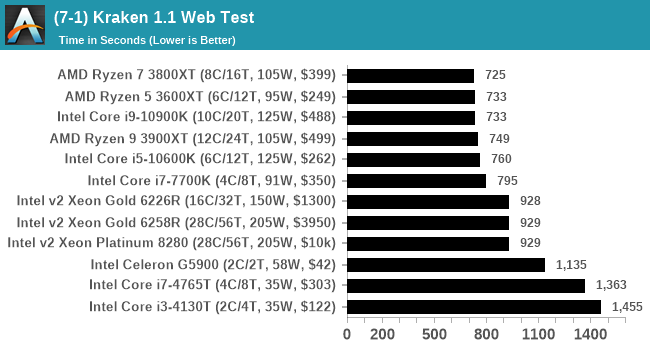
We loop through the 10-run test four times (so that’s a total of 40 runs), and average the four end-results. The result is given as time to complete the test, and we’re reaching a slow asymptotic limit with regards the highest IPC processors.
Google Octane 2.0
Our second test is also JavaScript based, but uses a lot more variation of newer JS techniques, such as object-oriented programming, kernel simulation, object creation/destruction, garbage collection, array manipulations, compiler latency and code execution.
Octane was developed after the discontinuation of other tests, with the goal of being more web-like than previous tests. It has been a popular benchmark, making it an obvious target for optimizations in the JavaScript engines. Ultimately it was retired in early 2017 due to this, although it is still widely used as a tool to determine general CPU performance in a number of web tasks.
Octane’s automation is a little different than the others: there is no direct website to go to in order to run the benchmark. The benchmark page is opened, but the user has to navigate to the ‘start’ button or open the console and initiate the JavaScript required to run the test. The test also does not show an obvious end-point, but luckily does try and aim for a fixed time for each processor. This is similar to some of our other tests, that loop around a fixed time before ending. Unfortunately this doesn’t work if the first loop goes beyond that fixed time, as the loop still has to finish. For Octane, we have set it to 75 seconds per run, and we loop the whole test four times.
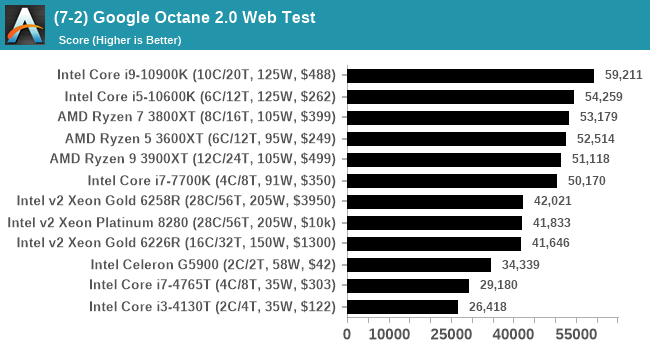
It is worth noting that in the last couple of Intel generations, there was a significant uptick in performance for Intel, likely due to one of the optimizations from the code base that filtered through into the microarchitecture. Octane is still an interesting comparison point for systems within a similar microarchitecture scope.
Speedometer 2: JavaScript Frameworks
Our newest web test is Speedometer 2, which is a test over a series of JavaScript frameworks to do three simple things: built a list, enable each item in the list, and remove the list. All the frameworks implement the same visual cues, but obviously apply them from different coding angles.
Our test goes through the list of frameworks, and produces a final score indicative of ‘rpm’, one of the benchmarks internal metrics. Rather than use the main interface, we go to the admin interface through the about page and manage the results there. It involves saving the webpage when the test is complete and parsing the final result.
We repeat over the benchmark for a dozen loops, taking the average of the last five.
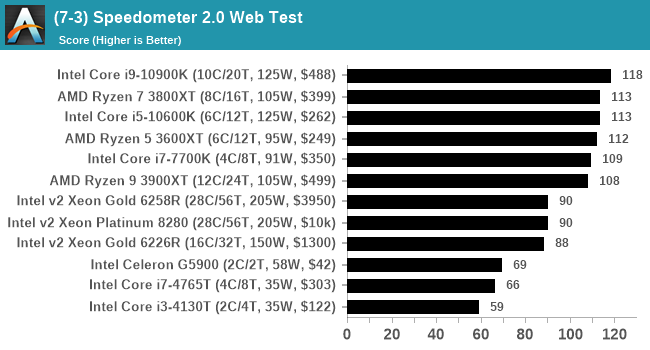


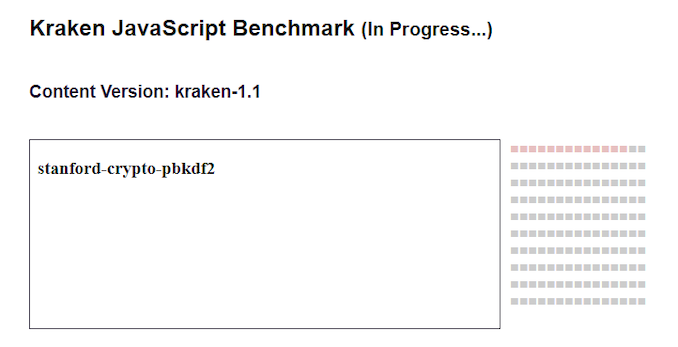
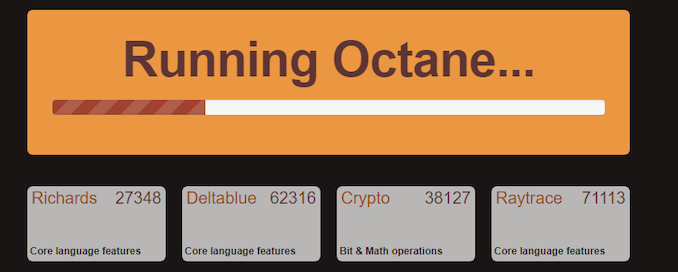
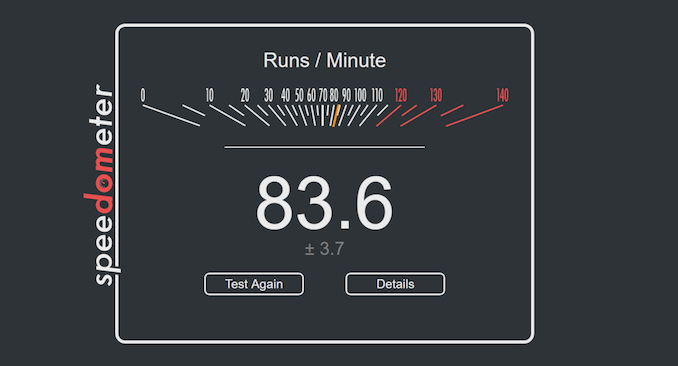








110 Comments
View All Comments
Smell This - Monday, July 20, 2020 - link
;- )
Oxford Guy - Monday, July 20, 2020 - link
"If there’s a CPU, old or new, you want to see tested, then please drop a comment below."• i7-3820. This one is especially interesting because it had roughly the same number of transistors as Piledriver on roughly the same node (Intel 32nm vs. GF 32 nm).
• 5775C
• 5675C (which outperformed and matched the 5775C in some games due to thermal throttling)
• 5775C with TDP bypassed or increased if this is possible, to avoid the aforementioned throttling
• I would really really like you to add Deserts of Kharak to your games test suite. It is the only game I know of that showed Piledriver beating Intel's chips. That unusual performance suggests that it was possible to get more performance out of Piledriver if developers targeted that CPU for optimization and/or the game's engine somehow simply suited it particularly.
• 8320E or 8370E at 4.7 GHz (non-turbo) with 2133 CAS 9-11-10 RAM, the most optimal Piledriver setup. The 9590 was not the most performant of the FX line, likely because of the turbo. A straight overclock coupled with tuned RAM (not 1600 CAS 10 nonsense) makes a difference. 4.7 GHz is a realistic speed achievable by a large AIO or small loop. If you want air cooling only then drop to 4.5 Ghz but keep the fast RAM. The point of testing this is to see what people were able to get in the real world from the AMD alternative for all the years they had to wait for Zen. Since we were stuck with Piledriver as the most performant Intel alternative for so so many years it's worth including for historical context. The "E" models don't have to be used but their lower leakage makes higher clocks less stressful on cooling than a 9000 series. 4.7 GHz was obtainable on a cheap motherboard like the Gigabyte UD3P, with strong airflow to the VRM sink.
• VIA's highest-performance model. If it won't work with Windows 10 then run the tests on it with 8.1. The thing is, though... VIA released an update fairly recently that should make it compatible with Windows 10. I saw Youtube footage of it gaming, in fact, with a discrete card. It really would be a refreshing thing to see VIA included, even though it's such a bit player.
• Lynnfield at 3 GHz.
• i7-9700K, of course.
Oxford Guy - Monday, July 20, 2020 - link
Regarding Deserts of Kharak... It may be that it took advantage of the extra cores. That would make it noteworthy also as an early example of a game that scaled to 8 threads.Oxford Guy - Monday, July 20, 2020 - link
Also, the Chinese X86 CPU, the one based on Zen 1, would be very nice to have included.Oxford Guy - Monday, July 20, 2020 - link
VIA CPUs tested with games as recently as 2019 (there was another video of the quad core but I didn't find it today with a quick search):https://www.youtube.com/watch?v=JPvKwqSMo-k
https://www.youtube.com/watch?v=Da0BkEW459E
The Zhaoxin KaiXian KX-U6880A would be nice to see included, not just the Chinese Zen 1 derivative.
Oxford Guy - Monday, July 20, 2020 - link
"due to thermal throttling"TDP throttling, to be more accurate. I suppose it could throttle due to current demand rather than temp.
axer1234 - Monday, July 20, 2020 - link
honestly i would love to know how different generation processor perform today especially higher core count. like prescott series pentium 4 athlon II phenomX6 core2 duo core2quad nehlam sandy bridge bulldozer etc with todays generation work loads and offeringin many scenario like word excel ppt photoshop it all works very well still in many offices
its just the new generation of application slowing it down for almost the same work etc
herefortheflops - Monday, July 20, 2020 - link
@Dr. Cutress.,As someone that has been dealing with similar or greater product testing challenges and configuration complexity for the better part of a decade or so, I would like to commend you for your ambitious goals and efforts so far. Additionally, I could be of high value to your effort if you are willing to discuss. I have reviewed in-depth the bench database (as well as competing websites) and I have come to the conclusion the Anandtech bench data is of very limited usefulness at present--and would require some significant changes to the data being collected/reported and the way things have been done to this point. I do understand where the industry is going, the questions the readers are going to be asking of the data, and the major comparisons that will be attempted with the data. Unfortunately, much of your effort may easily become irrelevant unless you proceed with some extreme caution to provide data with more utility. I also know methods to accomplish the desired result while reducing the size and cost of the task at hand. Reply by e-mail if you are interested in talking.
Best,
-A potential contributor to your effort.
Bensam123 - Tuesday, July 21, 2020 - link
Despite how impressive this is, one thing that hasn't been tackled is still multiplayer performance and it vastly changes recommendations for CPUs (doesn't effect GPUs as much).It goes from recommending a 6 core chip hands down to trying to make a case for 4 core chips still in this day and age. I own a 3900x and 2800 and I can tell you hands down Modern Warfare will gobble 70% of that 12 core chip, sometimes a bit more, that's equivalent to maxing out a 8 core of the same series. That vastly changes recommendations and data points. It's not just Modern Warfare. Overwatch, Black Ops 3(same engine as MW), and recently Hyper Scape will will make use of those extra cores. I have a widget to monitor CPU utilization in the background and I can check Task Manager. If I had a better video card I'm positive it would've sucked down even more of those 12 cores (my GPU is running at 100% load according to MSI AB).
This is a huge deal and while I understand, I get it, it's hard to reliably reproduce the same results in a multiplayer environment because it changes so much and generally seen as taboo from a hardware benchmarking standpoint, it is vastly different then singleplayer workloads to the point at which it requires completely different recommendations. Given how many people are making expensive hardware choices specifically because they play multiplayer games, I would even say most tech reviews in this day and age are irrelevant for CPU recommendations outside of the casual single player gamer. GPU recommendations are still very much on par, CPU is not remotely.
I talk about this frequently on my stream and why I still recommended the 1600 AF even when it was sitting at $105-125, it's a steal if you play multiplayer games, while most people that either read benchmarking websites or run benchmarks themselves will start making a case for a 4c Intel. 6 core is a must at the very least in this day and age.
Anandtech it's time to tread new ground and go into the uncharted area. Singleplayer results and multiplayer results are too different, you can't keep spinning the wheel and expect things to remain the same. You can verify this yourself just by running task manager in the background while playing one of the games I mentioned at the lowest settings regardless of being able to repeat those results exactly you'll see it's definitely a multi-core landscape for newer multiplayer games.
Not even touched on in the article.
Bensam123 - Tuesday, July 21, 2020 - link
70%, I have SMT off for clarification.